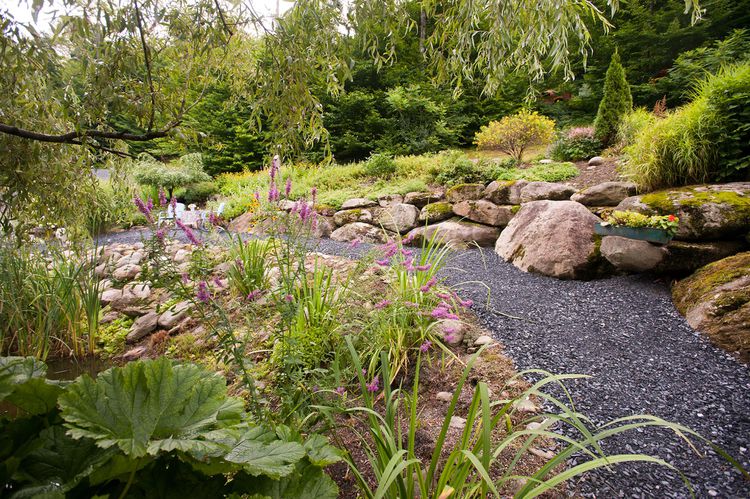When diving into your next landscaping project, plants might naturally come to mind first. But landscaping with rocks and stones in addition to plants can be a refreshing way to add texture, color, and year-round interest to your yard. These tips will help you landscape with rocks and stones effectively as stand-alone features or as the perfect accompaniments to your garden beds.
Is there a difference between landscaping rock and stone?
You might think of stone and rock as interchangeable words, but the two are actually very different things, says Barbara Pleasant, author of Garden Stone. "Technically a stone has been exposed to weather or water near the Earth's surface for a long period of time, while rocks come freshly broken from a larger mass below ground, most typically by blasting them out at a quarry." Weathered stone has rounded or brittle edges and numerous crevices. Pleasant adds that stone "will work best if you're working in a moist, shady site where moss will grow. Similarly, lace lichen will grow on stone, but not on the smooth surfaces of cut or broken rock."
Tips for Landscaping with Rock and Stone
Before you get started on your landscaping projects, here are some helpful hints for using rocks and stones in your yard.
1. Carefully Consider Where to Use Rock and Stone
There are unlimited possibilities for using rock and stone to enhance your landscape. Pleasant likes to use them as accents both in garden beds and containers. If you have a water feature, you can use stones to create a more natural-looking setting. For a more involved project, "building a stacked-stone wall is also lots of fun, and some types of stone make functional, eco-friendly pavers for pathways," she adds. In a rock garden, Pleasant suggests "simulating a stone ruin or tumbled-down building, which is traditionally planted with alpine plants, thymes, and other plants that crave superior drainage."
2. Think Through the Seasons
Pleasant points out that rock and stone can have a "strong unifying influence on the landscape year-round, so it can be a powerful and practical element in any scene." She advises envisioning what you want the spot to look like in two to three years, keeping in mind that the stone will become visually dominant in winter. "Ideally, you want to create scenes in which you can't tell which came first, the garden or the stone," she says. "It should look and feel as if the stone emerged from the ground, and all you did was collect the best pieces and put them in order, as humans have been doing for thousands of years."
3. Start Small
Even a few small stones or rocks can make a big impact when used correctly. For example, Pleasant points out that "planters and large containers that combine attractive stones with succulents are always stunning, and you can use specimen stones to reflect light from solar lanterns on your deck or patio."
4. Stick to One Type of Stone or Rock
In home landscapes, it's generally best to choose one type of stone and stick with it for major projects rather than mixing up colors and textures. "After all, you already have the textures from your house, deck, and other features. Adding one dominant stone texture looks natural, but several look junky," Pleasant says. Before making your selection, she suggests visiting your local stone yards to see what is affordable, is readily available, and matches any stones or boulders already present in your yard.
5. Choose the Best Type of Stone or Rock for Your Project
If you want to build a dry stack wall, for example, you'll need a different type of material than you would for a retaining wall. For a dry stack wall, look for "faced" stone, which has two flattish edges. "Limestone, sandstone, and other sedimentary-type rocks (which originated at the bottom of lakes and seas) naturally break into faced pieces, which are easy and fun to work with in landscaping projects," Pleasant says.
6. Don't Forget About Maintenance
For the most part, rocks and stones in your landscape won't require much upkeep. But in some situations, you may need to step in once in a while to keep everything looking the way you want it. For example, freezing and thawing over the winter can cause stones to shift, so a certain amount of fine-tuning may be needed to keep stone walkways and walls shipshape. Pleasant also points out that "crevices in stone walkways must usually be weeded, which I do by dousing them with boiling water from a teapot. On the other hand, clusters of well-placed stones in a fern garden need no upkeep at all, and rock gardens often need less weeding compared to fertile garden beds."
7. Keep Extra Rocks and Stones on Hand
Having a small collection of landscaping stones around can be handy, ready to fill in here and there when the whim or inspiration strikes. For example, Pleasant suggests that "when a flowerbed comes into its full glory, gild it with a temporary edging of stone. Gardens designed to attract butterflies might include small stone pillars situated on the east side to serve as early-morning basking spots."




















